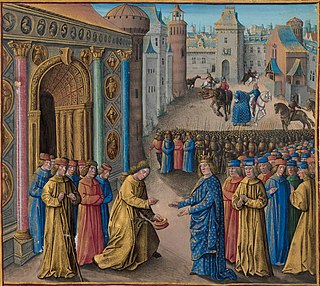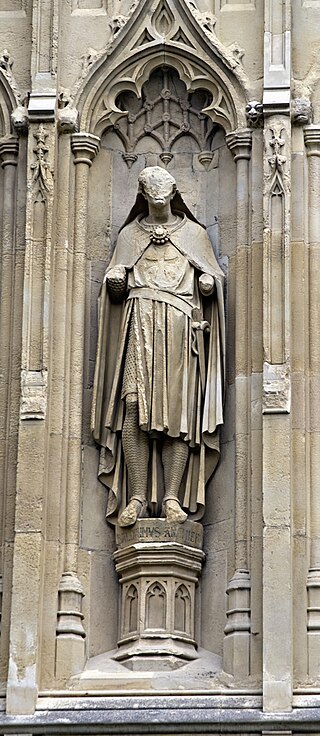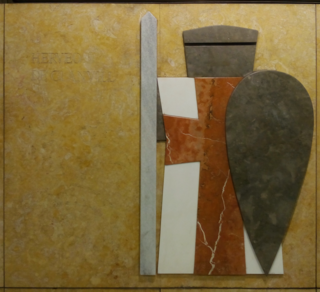Notes
- ↑ Herbermann, Charles, ed. (1913). . Catholic Encyclopedia . New York: Robert Appleton Company.
- ↑ Richardson, Douglas, Magna Carta Ancestry, Baltimore, Md., 2005, p. 297.
Gilbert de Hastings | |
|---|---|
| Bishop of Lisbon | |
| Church | Roman Catholic |
| See | Diocese of Lisbon |
| In office | 1147–1166 |
| Predecessor | Vacant |
| Successor | Álvaro |
| Personal details | |
| Born | |
| Died | 27 April 1166 Lisbon, Portugal |
Gilbert de Hastings (Portuguese : Gilberto de Hastings; died 1166) was an English monk in the Christian army of the Second Crusade who fought in the Siege of Lisbon. After the victory, he was chosen to be the first Bishop of Lisbon. [1] Prior to his incumbency, the see of Lisbon was occupied by a Bishop of the mozarabic rite, that was killed by the pillaging crusaders, as described by the crusader monk Osbernus in De expugniatione Lyxbonensi (The Conquest of Lisbon). His antecedents are unclear, but it seems probable that he was a younger son of the well-known Anglo-Norman de Hastings family who held the Lordship of the Manor of Ashill in Norfolk, and who, at this time, were Hereditary Stewards of the Abbey of Bury St Edmunds. [2]

Bernard of Clairvaux, O. Cist., venerated as Saint Bernard, was an abbot, mystic, co-founder of the Knights Templar, and a major leader in the reformation of the Benedictine Order through the nascent Cistercian Order.
Year 1142 (MCXLII) was a common year starting on Thursday of the Julian calendar.
The 1100s was a decade of the Julian Calendar which began on January 1, 1100, and ended on December 31, 1109.

Year 1095 (MXCV) was a common year starting on Monday of the Julian calendar.

Year 1179 (MCLXXIX) was a common year starting on Monday of the Julian calendar.

Year 1148 (MCXLVIII) was a leap year starting on Thursday of the Julian calendar.
Year 1108 (MCVIII) was a leap year starting on Wednesday of the Julian calendar.

Year 1287 (MCCLXXXVII) was a common year starting on Wednesday of the Julian calendar.

The Cathedral of Saint Mary Major, often called Lisbon Cathedral or simply the Sé, is a Roman Catholic cathedral located in Lisbon, Portugal. The oldest church in the city, it is the seat of the Patriarchate of Lisbon. Built in 1147, the cathedral has survived many earthquakes and has been modified, renovated and restored several times. It is nowadays a mix of different architectural styles. It has been classified as a National Monument since 1910.

The Council of Clermont was a mixed synod of ecclesiastics and laymen of the Catholic Church, called by Pope Urban II and held from 17 to 27 November 1095 at Clermont, Auvergne, at the time part of the Duchy of Aquitaine.

Steyning is a town and civil parish in the Horsham district of West Sussex, England. It is located at the north end of the River Adur gap in the South Downs, four miles (6.4 km) north of the coastal town of Shoreham-by-Sea.

The Metropolitan Patriarchate of Lisbon is a Latin Church ecclesiastical territory or patriarchal archdiocese of the Catholic Church in Lisbon, the capital of Portugal.

The siege of Lisbon, from 1 July to 25 October 1147, was the military action against the Muslim-ruled Taifa of Badajoz that brought the city of Lisbon under the definitive control of the new Christian power, the Kingdom of Portugal.

Baldwin of Forde or Ford was Archbishop of Canterbury between 1185 and 1190. The son of a clergyman, he studied canon law and theology at Bologna and was tutor to Pope Eugene III's nephew before returning to England to serve successive bishops of Exeter. After becoming a Cistercian monk he was named abbot of his monastery at Forde and subsequently elected to the episcopate at Worcester. Before becoming a bishop, he wrote theological works and sermons, some of which have survived.
Savaric fitzGeldewin was an Englishman who became Bishop of Bath and Glastonbury in England. Related to his predecessor as well as to Emperor Henry VI, he was elected bishop on the insistence of his predecessor, who urged his election on the cathedral chapter of Bath. While bishop, Savaric spent many years attempting to annexe Glastonbury Abbey as part of his bishopric. Savaric also worked to secure the release of King Richard I of England from captivity, when the king was held by Emperor Henry VI.

De expugnatione Lyxbonensi is an eyewitness account of the Siege of Lisbon at the start of the Second Crusade, and covers the expedition from the departure of the English contingent on 23 May 1147 until the fall of Lisbon on 28 June 1148. It was written in Latin by one Raol, an Anglo-Fleming and probably a chaplain of Hervey de Glanvill in the army from East Anglia. It is an important source for the organisation of the crusade, especially among the middle ranks of society. An English translation by Charles Wendell David appeared in 1936 and was reprinted in 2001.

Hervey de Glanvill [Glanville] was an Anglo-Norman nobleman and military leader. He was a scion of a younger line of the Glanvill family, which had been established in East Anglia, especially Suffolk, since before 1086. He had several sons and daughters, the most prominent of which was Ranulf de Glanvill, who became justiciar of England.

The siege of Alcácer do Sal lasted from 30 July to 18 October 1217. The well fortified city of Alcácer do Sal was a frontier outpost of the Almohad Caliphate facing Portugal. It was besieged by forces from Portugal, León, the military orders and the Fifth Crusade. The latter were led by Count William I of Holland. The expedition was the brainchild of Bishop Soeiro II of Lisbon, whose diocese was threatened by regular raids from Alcácer. King Afonso II of Portugal did not take part in person, but the city was incorporated into his kingdom after its capitulation. The crusaders who took part in the siege, mainly from the Rhineland and the Low Countries, did so without papal authorization and were afterwards ordered to continue on to the Holy Land.
Soeiro Viegas was the bishop of Lisbon from 1211 until his death. He is most notable for launching the successful siege of Alcácer do Sal in 1217. He spent eight or more years of his episcopate in Rome, where he was on behalf of King Afonso II in 1211–1212 and attending the Fourth Lateran Council in 1215–1216. He was there litigating his own troubles in 1223 and 1226–1231. The first seven years of his episcopate were characterized by good relations with the crown, but the rest of his episcopate was characterized by conflict. He was exiled from his diocese for a time in 1223–1224.

The Carmen de expugnatione Salaciae is a Latin epic poem in 115 elegiac couplets describing the siege of Alcácer do Sal in 1217. It was written by Goswin of Bossut for Soeiro Viegas, bishop of Lisbon.